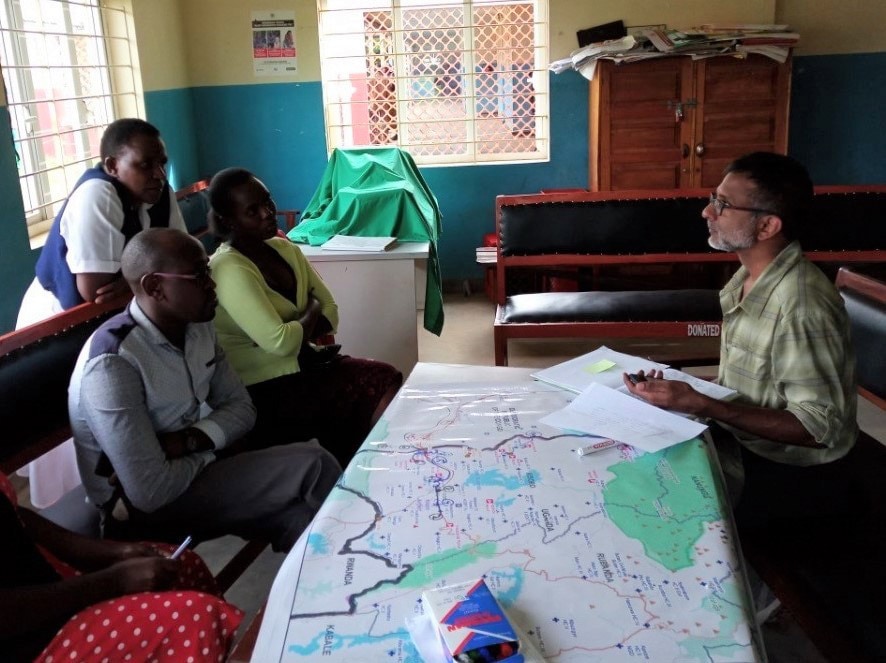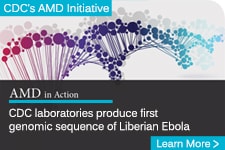Roads to Uganda

CDC’s Satish Pillai, right, leads a participatory mapping session with healthcare workers at a hospital in Uganda’s Kisoro District hospital, near the border with Uganda, May 2019.
Credit: Courtesy Satish Pillai
Along Uganda’s southwestern border, people regularly cross into and out of the Democratic Republic of the Congo (DRC).
They come to sell goods at Ugandan markets, to visit family, to seek health care, or to seek refuge from the ongoing conflict in DRC. However, because the Ebola outbreak is still active in DRC in areas near the Ugandan border, people crossing the border might be carrying the deadly virus.
Which is why Satish Pillai found himself sitting around a table full of maps in May 2019, talking to traders, bus drivers, and others who live and work along the border. Pillai, a CDC medical officer, was supporting CDC’s Ebola response as part of the Global Border Health Team. He was working with Uganda’s Ministry of Health, staff from the CDC Uganda office, and partners at Makerere University’s Infectious Diseases Institute to prepare for the possibility that Ebola might enter Uganda from DRC.
“There are a handful of official border crossings, but for the most part, it’s an open border. People are passing back and forth,” Pillai says.
Unofficial crossings occur often, so it’s impossible to track people there. Even when people enter through Uganda’s official points of entry, there is no way knowing if they are carrying the virus if they are not symptomatic. For these reasons, the preparedness activities Pillai assisted with took a different approach: finding out where people go after they cross the border.
This approach was developed by CDC and is known as Population Connectivity Across Borders, or “PopCAB,” assessments. Through facilitated discussions with key stakeholders and focus groups within communities, interviewers learned about patterns of migration and movement into, through, and out of their communities to help predict where Ebola could spread within Uganda.
Pillai talked with bus and motorcycle taxi drivers about where they picked up and dropped off passengers. He learned about the most frequently visited markets and healthcare facilities. He witnessed how easy it could be to cross the border at an unmarked road. He heard from Uganda’s community leaders about challenges they faced because of insecurity on the DRC side of the border. He also found that the traffic is not just one-way. “Some Ugandans have been crossing into DRC to grow crops in the rich soil of fields that have been left untilled during years of turmoil,” he says.
The assessments helped quickly identify the locations and the most common reasons for movement of people between DRC and Uganda, as well as the most frequent locations for border crossings. The results helped Ugandan authorities make decisions about where to focus their efforts and resources to prevent spread of Ebola into Uganda.
“In the setting of this continuous open border, this was important to help best apply limited resources,” Pillai says.
Uganda’s preparedness efforts were tested in the summer of 2019 when a child sick with Ebola crossed with relatives into Uganda from the DRC through a porous border. After the child was identified in a Uganda hospital, Ugandan authorities moved quickly to investigate where the child and his relatives may have traveled after entering the country, and they followed up by vaccinating anyone who had been in contact with the sick child and people who came in contact with those people. Two of the child’s relatives were also found to be sick with Ebola, but the cluster was quickly contained at just three imported cases with no additional spread.
Pillai grew up in Cleveland, Ohio. He went to college and medical school at Case Western Reserve University, received additional clinical training in Boston, and then spent seven years practicing as a hospital physician.
His sister was a member CDC’s Epidemic Intelligence Service (EIS), the “disease detectives.” She helped convince him to choose public health as a career and to focus on population-level health. Therefore, he returned to school, earned a master’s degree in public health from Harvard University, and eventually was accepted into EIS in 2011.
He was part of CDC’s response to the worst Ebola outbreak to date, the 2014-2016 West Africa outbreak. He also helped lead CDC’s 2016 Zika response. With the current Ebola outbreak still ongoing, he encourages others to join the response as well.
“I had a small window to help during this response, and it was incredibly rewarding,” he said.

